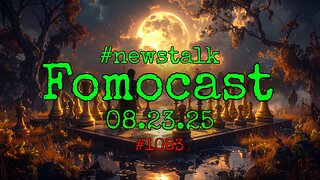Premium Only Content

Arthur Conan Doyle: Sherlock Holmes
Author Arthur Conan Doyle wrote 60 mystery stories featuring the wildly popular detective character Sherlock Holmes and his loyal assistant Watson.
In 1890, Arthur Conan Doyle's novel, A Study in Scarlet introduced the character of Detective Sherlock Holmes. Doyle would go on to write 60 stories about Sherlock Holmes. He also strove to spread his Spiritualism faith through a series of books that were written from 1918 to 1926. Doyle died of a heart attack in Crowborough, England on July 7, 1930.
Early Life
On May 22, 1859, Arthur Conan Doyle was born to an affluent, strict Irish-Catholic family in Edinburgh, Scotland. Although Doyle's family was well-respected in the art world, his father, Charles, who was a life-long alcoholic, had few accomplishments to speak of. Doyle's mother, Mary, was a lively and well-educated woman who loved to read. She particularly delighted in telling her young son outlandish stories. Her great enthusiasm and animation while spinning wild tales sparked the child's imagination. As Doyle would later recall in his biography, "In my early childhood, as far as I can remember anything at all, the vivid stories she would tell me stand out so clearly that they obscure the real facts of my life."
Medical Education and Career
When Doyle graduated from Stonyhurst College in 1876, his parents expected that he would follow in his family's footsteps and study art, so they were surprised when he decided to pursue a medical degree at the University of Edinburgh instead. At med school, Doyle met his mentor, Professor Dr. Joseph Bell, whose keen powers of observation would later inspire Doyle to create his famed fictional detective character, Sherlock Holmes. At the University of Edinburgh, Doyle also had the good fortune to meet classmates and future fellow authors James Barrie and Robert Louis Stevenson. While a medical student, Doyle took his own first stab at writing, with a short story called The Mystery of Sasassa Valley. That was followed by a second story, The American Tale, which was published in London Society.
During Doyle's third year of medical school, he took a ship surgeon's post on a whaling ship sailing for the Arctic Circle. The voyage awakened Doyle's sense of adventure, a feeling that he incorporated into a story, Captain of the Pole Star.
In 1880, Doyle returned to medical school. Back at the University of Edinburgh, Doyle became increasingly invested in Spiritualism or "Psychic religion," a belief system that he would later attempt to spread through a series of his written works. By the time he received his Bachelor of Medicine degree in 1881, Doyle had denounced his Roman Catholic faith.
Sherlock Holmes
In 1886, newly married and still struggling to make it as an author, Doyle started writing the mystery novel A Tangled Skein. Two years later, the novel was renamed A Study in Scarlet and published in Beeton's Christmas Annual. A Study in Scarlet, which first introduced the wildly popular characters Detective Sherlock Holmes and his assistant, Watson, finally earned Doyle the recognition he had so desired. It was the first of 60 stories that Doyle would pen about Sherlock Holmes over the course of his writing career. Also, in 1887, Doyle submitted two letters about his conversion to Spiritualism to a weekly periodical called Light.
Doyle continued to actively participate in the Spiritualist movement from 1887 to 1916, during which time he wrote three books that experts consider largely autobiographical. These include Beyond the City (1893), The Stark Munro Letters (1895) and A Duet with an Occasional Chorus (1899). Upon achieving success as a writer, Doyle decided to retire from medicine.
The prolific author also composed four of his most popular Sherlock Holmes books during the 1890s and early 1900s: The Sign of Four (1890), The Adventures of Sherlock Holmes (1892), The Memoirs of Sherlock Holmes (1894) and The Hound of Baskervilles, published in 1901. In 1893, to Doyle's readers' disdain, he had attempted to kill off his Sherlock Holmes character in order to focus more on writing about Spiritualism. In 1901, however, Doyle reintroduced Sherlock Holmes in The Hound of Baskervilles and later brought him back to life in The Adventure of the Empty House so the lucrative character could earn Doyle the money to fund his missionary work.
In 1928, Doyle's final twelve stories about Sherlock Holmes were published in a compilation entitled The Casebook of Sherlock Holmes.
Death
Having recently been diagnosed with Angina Pectoris, Doyle stubbornly ignored his doctor's warnings, and in the fall of 1929, embarked on a spiritualism tour through the Netherlands. He returned home with chest pains so severe that he needed to be carried on shore and was thereafter almost entirely bedridden at his home in Crowborough, England. Rising one last time on July 7, 1930, Doyle collapsed and died in his garden while clutching his heart with one hand and holding a flower in the other.
-
 1:00
1:00
Literati
1 year agoAwakening
97 -
 6:34:50
6:34:50
SpartakusLIVE
10 hours ago#1 Saturday Spartoons on RUMBLE PREMIUM
110K7 -
 1:04:59
1:04:59
Man in America
11 hours ago“Summoning the Demon” — The AI Agenda Is FAR WORSE Than We Know w/ Kay Rubacek
46.5K30 -
 2:16:48
2:16:48
Tundra Tactical
9 hours ago $0.11 earned🎯💥 The World’s Okayest Gun Show 🔫😂 | LIVE Tonight on Rumble!
27.2K -
 3:36:03
3:36:03
Mally_Mouse
1 day ago🌶️ 🥵Spicy BITE Saturday!! 🥵🌶️- Let's Play: Tower Unite!
53.6K2 -
 58:59
58:59
MattMorseTV
9 hours ago $1.49 earned🔴Trump just BROKE Newsom.🔴
68.3K85 -
 18:14
18:14
Her Patriot Voice
9 hours agoWho Is WORSE for NYC: Trump Girl or Socialist?
51.1K33 -
 3:39:42
3:39:42
SavageJayGatsby
9 hours agoSpicy Saturday with Mally! | Road to 100 | $300 Weekly Goal for Spicy Bites!
49.2K1 -
 3:35:50
3:35:50
FomoTV
10 hours ago🚨 Swamp Theater: FBI Raids Bolton 🕵 Still NO Epstein Files, Trump's Troops & the Red Heifer Hoax 🐂 | Fomocast 08.23.25
22.4K7 -
 6:04:40
6:04:40
Akademiks
14 hours agoRoc Nation & Meg Thee Stallion did a 7 HOUR Deposition with me. Drake Secret Kid Finally Revealed.
58.7K2